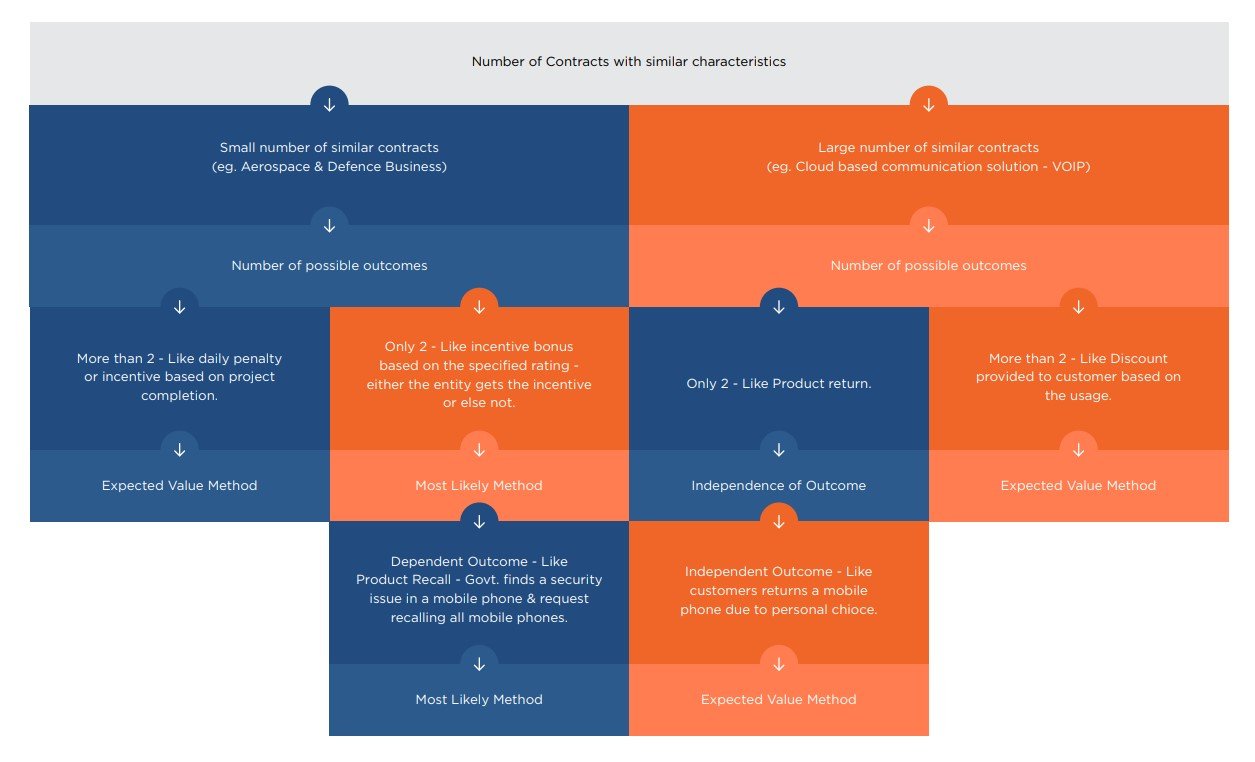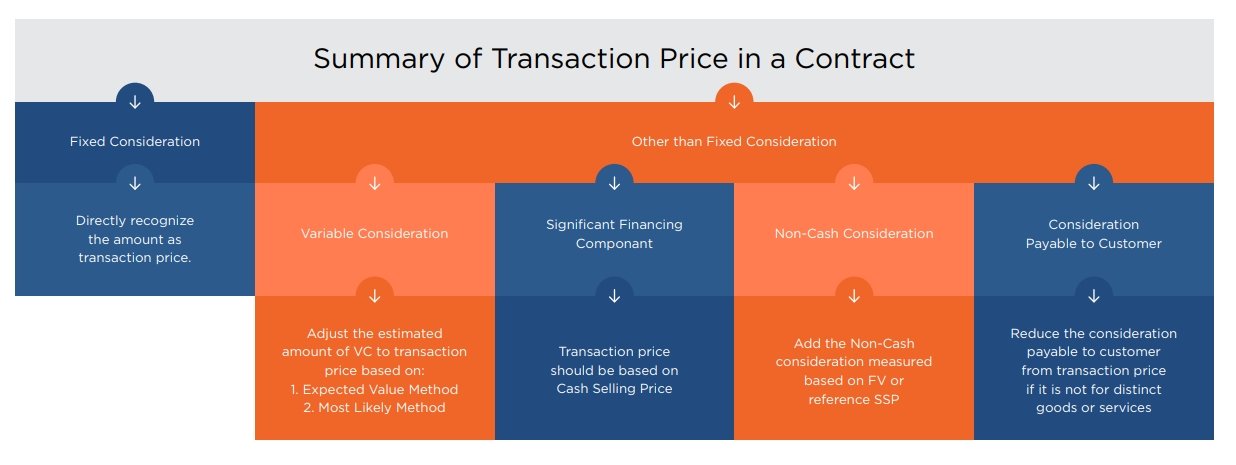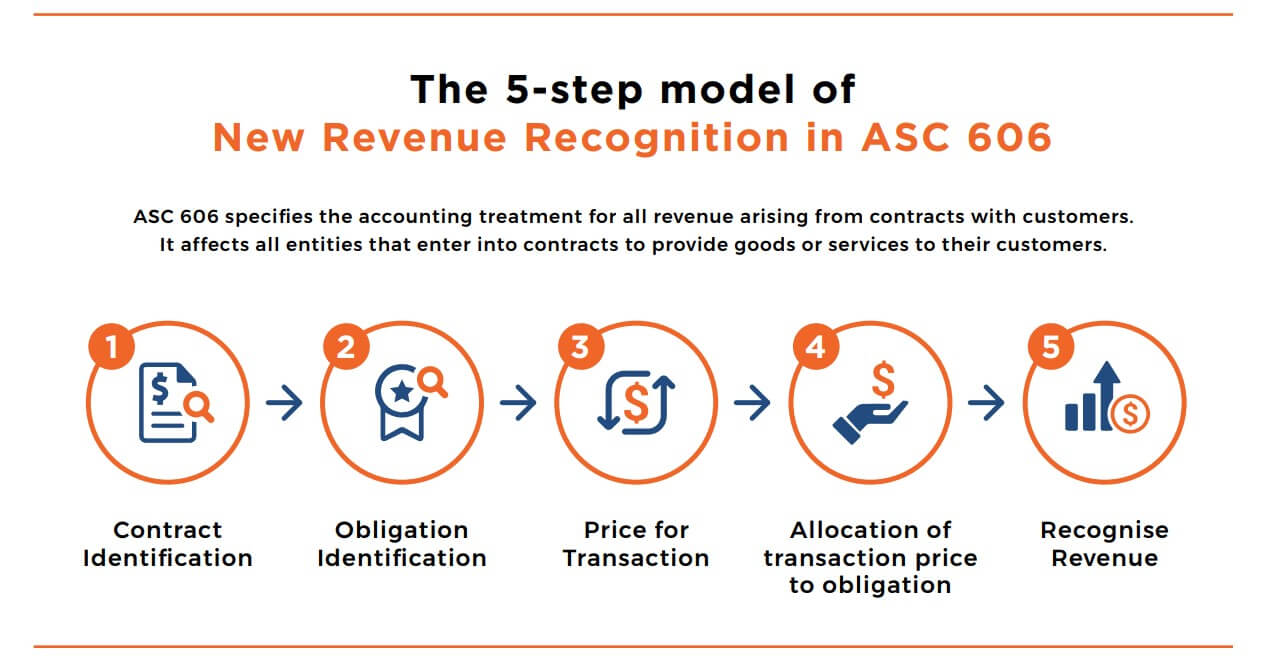21 Feb ASC 606: Step 3 – Determining the Transaction Price

Revenue is an important point of concern to the users of Financial Statements in assessing an entity’s Financial Performance and Position.
Accounting Standard Codification (ASC) 606 – Revenue from Contract with Customers is an Industry-wide revenue recognition guidance which has been formulated by the Financial Accounting Standard Board (FASB). This was a joint task by Financial Accounting Standard Board (FASB) and International Accounting Standard Board (IASB) to clarify the principles for Revenue Recognition and to develop common revenue standard for U.S. GAAP and IFRS.
ASC 606 will be applicable across all the industries and aid in recognizing revenue from all the types of transactions, except those transactions which are covered by more specific guidelines (for example – Insurance Contract or Leasing Contract).
This document is to introduce the readers to Step 3 of ASC 606 – ‘Determine the transaction price’.
This document covers:
1. Definition of the transaction price.
2. Determination of transaction price based on various types of consideration.
WHAT IS TRANSACTION PRICE?
As per ASC 606-10-32-2, The transaction price is the amount of consideration to which an entity expects to be entitled in exchange for transferring promised goods or services to a customer, excluding amounts collected on behalf of third parties (for example, some sales taxes). The consideration promised in a contract with a customer may include fixed amounts, variable amounts, or both.
A simple example on transaction price would be, a customer goes to a shopping mall and purchases a mobile worth $500, so in this scenario, the amount of consideration is $500, viz. the transaction price, in exchange of transferring the promised goods, viz. Mobile.

DETERMINE THE TRANSACTION PRICE
Well, the definition of transaction is pretty much straight forward but determining the transaction price is a bit sophisticated when variable amount comes in to picture, however, if one has clear understanding on the variable and fixed amount aberration, then determining the transaction price becomes much easier.
As per ASC 606-10-32-2, An entity shall consider the terms of the contract and its customary business practices to determine the transaction price.
As per ASC 606-10-32-3, The nature, timing, and amount of consideration promised by a customer affect the estimate of the transaction price.
A simple example on determining transaction price would be a customer purchasing a mobile worth $500, this is pretty much straight forward scenario where a customer is paying $500 in exchange of mobile, so the transaction price is $500, and the revenue recognition will be for $500 for the seller. The transaction price can be easily determined based on the terms of contract, if the consideration is fixed one.
Now just to make it complicated, what if the customer has a right to return the mobile with full refund, then in this scenario the mobile seller cannot directly determine the transaction price as $500 and recognize the revenue for $500.
To determine the transaction price, a clear distinction of the various considerations other than fixed consideration must be established first and then perform step by step calculation based on the types of consideration established.
When determining the transaction price, an entity shall consider the effects of the following, which is various types of consideration in a contract other than fixed consideration:

1. VARIABLE CONSIDERATION
Variable consideration is consideration in a contract which can vary and not fixed based on discounts, rebates, refunds, credits, price concessions, incentives, performance bonuses, penalties, or other similar items, in other words, consideration contingent on the occurrence or nonoccurrence of future event and not known as on the day when the contract was entered is Variable Consideration. Entity should adjust the variable consideration to the transaction price.
As per ASC 606-10-32-14 At the end of each reporting period, an entity shall update the estimated transaction price (including updating its assessment of whether an estimate of variable consideration is constrained) to represent faithfully the circumstances present at the end of the reporting period and the changes in circumstances during the reporting period.
Constraining Estimates of Variable Consideration
As per ASC 606, Variable Consideration should be included in the transaction price, if only it is probable that the subsequent reversal of the cumulative revenue recognized (revenue recognized till date) will not occur when the uncertainty associated with the variable consideration is subsequently resolved.
As per ASC 606-10-32-12 – Factors to be considered while assessing the probability of significant reversal in the amount of cumulative revenue recognized will not occur once the uncertainty related to the variable consideration.
An entity must consider the following Factors that could increase the likelihood, or the magnitude of a revenue reversal include, but are not limited to:
1) The amount of consideration is highly susceptible to factors outside the entity’s influence. Those factors may include volatility in a market, the judgment or actions of third parties, weather conditions, and a high risk of obsolescence of the promised good or service.
2) The uncertainty about the amount of consideration is not expected to be resolved for a long period of time.
3) The entity’s experience (or other evidence) with similar types of contracts is limited, or that experience (or other evidence) has limited predictive value.
4) The entity has a practice of either offering a broad range of price concessions or changing the payment terms and conditions of similar contracts in similar circumstances.
5) The contract has a large number and broad range of possible consideration amounts.
Some practical example on Variable Consideration
- Quantity discounts provided to customers on bulk purchases.
- Trade discounts provided to middlemen (Like bookseller getting discount from book Publisher) for the functions they perform in the distribution of commodities.
- Promotional discounts are given to distributors (like a discount provided to the local newspaper)
- Geographical discount is given to customers.
- Mail-in Rebate provided to the customer.
- Compensation paid (refund) to a customer for over-invoicing or for returned goods.
- Sales based or usage-based Royalty.
As per ASC 606-10-32-7 – Variable Consideration in addition to Terms of Contract:
Variable Consideration can be explicitly stated in a contract (terms of the contract) but sometimes business must go beyond the terms of the contract to identify the variable consideration, those circumstances can be defined as below:
1) The customer has a valid expectation arising from an entity’s customary business practices, published policies, or specific statements that the entity will accept an amount of consideration that is less than the price stated in the contract. That is, it is expected that the entity will offer a price concession. Depending on the jurisdiction, industry, or customer this offer may be referred to as a discount, rebate, refund, or credit.
2) Other facts and circumstances indicate that the entity’s intention, when entering into the contract with the customer, is to offer a price concession to the customer.
As per ASC 606-10-32-5 – Estimation of Variable consideration:
If the consideration promised in a contract includes a variable amount, an entity shall estimate the amount of consideration to which the entity will be entitled in exchange for transferring the promised goods or services to a customer.
In other words, as variable consideration cannot be determined upfront when the contract is entered, hence, business must estimate the Variable Consideration.
As per ASC 606-10-32-8 – Methods for estimating Variable Consideration
An entity shall estimate an amount of variable consideration by using either of the following methods, depending on which method the entity expects to better predict the amount of consideration to which it will be entitled:
1) The Expected Value: The expected value is the sum of probability-weighted amounts in a range of possible consideration amounts. An expected value may be an appropriate estimate of the amount of variable consideration if an entity has a large number of contracts with similar characteristics.
2) The Most likely amount: The most likely amount is the single most likely amount in a range of possible consideration amounts (that is, the single most likely outcome of the contract). The most likely amount may be an appropriate estimate of the amount of variable consideration if the contract has only two possible outcomes (for example, an entity either achieves a performance bonus or does not).
Choosing the right estimation method for Variable Consideration is sophisticated, below flow chart will help entity to choose the correct estimation method to a certain level.

2. SIGNIFICANT FINANCING COMPONENT IN THE CONTRACT
Introduction to Significant Financing Component
While determining the transaction price, an entity shall adjust the amount of consideration with respect to the time value of money, if the timing of payment to be made by customer under the contract provides some significant benefit of financing to the customer or the entity for the transfer of goods or services to the customer. The Significant financing benefit could be explicit or implicit in the contract.
The idea behind the significant financing component is that entity should consider the revenue based on the price that a customer would have paid at the time of transferring the goods or services to the customer by the entity i.e. Cash Selling Price (If the payment was made immediately).
An entity should adjust for Significant Financing Component if only the financing component is significant after considering all relevant facts and considerations.
So how does an entity identify whether financing component is significant or not? Entity should consider below facts for deriving on the significance of the financing component:
1) The difference between promised consideration and Cash selling Price.
2) The combined effect of both of the following:
I. The expected length of time between when the entity transfers the promised goods or services to the customer and when the customer pays for those goods or services
II. The prevailing interest rates in the relevant market.
Situations where Significant Financing Component is not considered in a Contract.
As per ASC 606-10-32-17, a contract with a customer would not have a significant financing component if any of the following factors exist:
1) The customer paid for the goods or services in advance, and the timing of the transfer of those goods or services is at the discretion of the customer.
2) A substantial amount of the consideration promised by the customer is variable, and the amount or timing of that consideration varies on the basis of the occurrence or nonoccurrence of a future event that is not substantially within the control of the customer or the entity (for example, if the consideration is a sales-based royalty).
3) The difference between the promised consideration and the cash selling price of the good or service arises for reasons other than the provision of finance to either the customer or the entity, and the difference between those amounts is proportional to the reason for the difference. For example, the payment terms might provide the entity or the customer with protection from the other party failing to adequately complete some or all of its obligations under the contract.
An entity can use practical expedient as well, if the period between the transfer of goods or services and when the customer pays is less than a year then, entity can skip adjusting the significant Financing component to the transaction price.
Presentation of Significant Financing Component
An entity shall present the effects of financing (interest income or interest expense) separately from revenue from contracts with customers in the Financial statement. Interest income or interest expense is recognized only to the extent that a contract asset or a contract liability is recognized in accounting for a contract with a customer.
3. NONCASH CONSIDERATION
Introduction to Noncash Consideration
Contracts where the customer promises consideration in a form other than cash, Entity should adjust such noncash consideration in transaction price. The noncash consideration should be measured at fair value and if the entity cannot reasonably estimate the fair value of the noncash consideration then the entity should measure the consideration indirectly by reference to the standalone selling price of the goods or services promised to the customer (or class of customer) in exchange for the consideration.
As per ASC 606-10-32-23, The fair value of the noncash consideration may vary because of the form of the consideration (for example, a change in the price of a share to which an entity is entitled to receive from a customer).
If the fair value of the noncash consideration promised by a customer varies for reasons other than only the form of the consideration (for example, the fair value could vary because of the entity’s performance), an entity shall apply the guidance applicable to Constraining Estimates of variable consideration.
AS per ASC 606-10-32-24, If a customer contributes goods or services (for example, materials, equipment, or labor) to facilitate an entity’s fulfillment of the contract, the entity shall assess whether it obtains control of those contributed goods or services. If so, the entity shall account for the contributed goods or services as noncash consideration received from the customer or else not.
4. CONSIDERATION PAYABLE TO CUSTOMER
Introduction to Consideration payable to customer
As per ASC 606-10-32-25, Consideration payable to a customer includes cash amounts that an entity pays, or expects to pay, to the customer (or to other parties that purchase the entity’s goods or services from the customer).
Consideration payable to a customer also includes credit or other items (for example, a coupon or voucher) that can be applied against amounts owed to the entity (or to other parties that purchase the entity’s goods or services from the customer).
An entity shall account for consideration payable to a customer as a reduction of the transaction price and, therefore, of revenue unless the payment to the customer is in exchange for a distinct good or service that the customer transfers to the entity.
If the consideration payable to a customer includes a variable amount, an entity shall estimate the transaction price as per the guidelines rules on Variable consideration.
Example:
A Mobile manufacturer enters into a one-year contract to sell Mobiles to a retail company. The customer commits to buy at least $500,000 of products for the year. The contract states that the entity need to make a nonrefundable payment of $45,000 to the customer upfront. The $45,000 payment will compensate the customer for the changes it needs to make to its shelving to accommodate the entity’s products.
In this case the payment to the customer is not in exchange for a distinct good or service that transfers to the entity. This is because the entity does not obtain control of any rights to the customer’s shelves and the shelving is of no value to the entity. Consequently, the entity determines that the payment is a reduction of the transaction price.
Hence in this example the entity can consider the nonrefundable payment as consideration payable to customer and adjust the amount against the transaction price as deduction.

Did you find this article on allocation of transaction price helpful? Would you like more situational examples on how to determine the transaction price in a contract?
We will be happy to answer any questions/queries regarding this and any other topics regarding Revenue Recognition and ASC 606.

